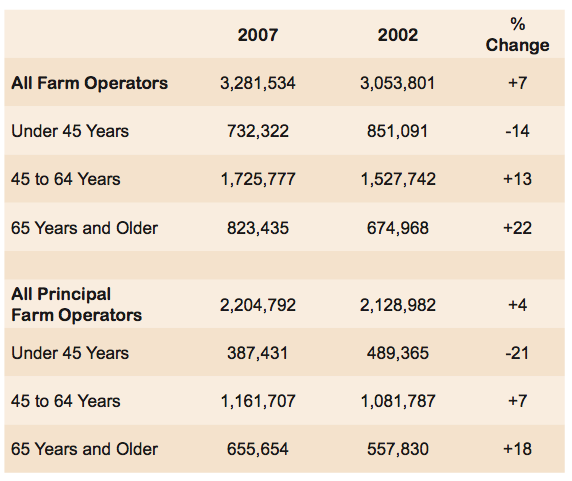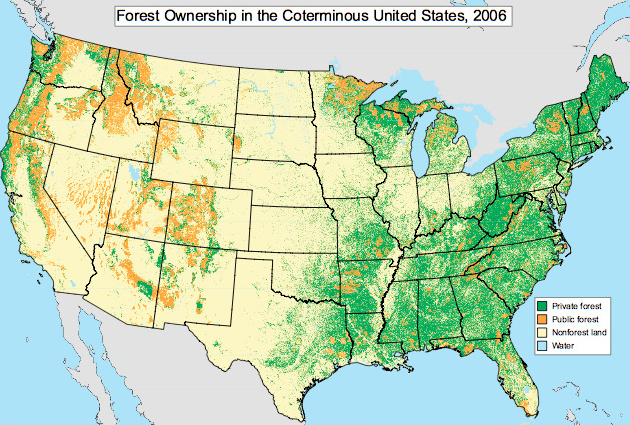The Age Cliff Facing Private Landowners
By: Amos S. Eno
Posted on:10/12/2012 Updated:02/06/2013One more threat to working lands – the average age of farmers, ranchers
and forest owners continues to climb, with only words not action to stem the tide.
One more threat to working lands – the average age of farmers, ranchers
and forest owners continues to climb, with only words not action to stem the tide.
Everybody is talking about the fiscal cliff ahead. But what nobody is paying any attention to is the age cliff facing our private landowners.
When the U.S. Department of Agriculture mails out 2012 Census of Agriculture survey forms to farmers across the country this December to update its 2007 Census, one key set of questions will focus on age. If the 2012 returns match the established trend, the average age of landowners will have continued to climb despite efforts at USDA, Farm Bureau, and elsewhere to make agriculture more competitive with other career choices.
USDA Secretary Tom Vilsack zeroed in on the age issue at Drake University Law School’s 2012 Forum on America’s New Farmers in August. He warned that “We have an aging farming population. If left unchecked, this could threaten our ability to produce the food we need – and also result in the loss of tens of thousands of acres of working lands that we rely on to clean our air and water.”
The demographics of our landowners are startling. We need to do more than just talk about it.
USDA’s 2007 Census of Agriculture showed just how serious the trend toward aging farm demographics has become:
“A long term trend observed in the Census of Agriculture is the aging of farm operators. The average age of the principal farm operator has increased roughly one year in each [five-year] census cycle, from 50.3 in 1978 to 57.1 in 2007. The majority of farm operators are between 45 and 64, but the fastest growing group of farm operators is those 65 years and older. In addition to the more than two million principal operators, the new data show the 2007 Census counted an additional 1.1 million operators on farms. These second and third operators on average are younger than the principal operators. However, this group of operators also showed an increase in average age between 2002 and 2007.”
This USDA chart below tells the story, showing that for the 2002-2007 period, farm operator numbers were up 22% for those 65 and older while the count for operators under 45 dropped 14%.

Aging Farmers - Source: USDA 2007 Census of Agriculture
Another clear warning sign is glaringly obvious in this young vs. old finding:
“The 2007 Census of Agriculture shows a significant difference in the number of farmers at opposite ends of the age spectrum. In 2007, there were 54,147 operators under the age of 25 and 289,999 operators 75 years and over.”
The age divide is even more dramatic in the case of America’s 10.4 million private family forest owners. USDA’s 2006 survey found 229,000 forest owners under 35 years old versus 1,477,000 age 75 or older. While USDA’s farmer survey showed 5.4 times as many elderly as young farmers, the ratio is 6.4 in the case of forest owners even though the forest survey included owners up to 35 years old in the younger group rather than the age 25 cutoff used for the farm survey. With the 2012 Ag Census expected to show farmers’ average age over 58, the Forest Service’s Brett Butler estimates that the average age of foresters has climbed to 63 this year, up from 60 in 2004.
USDA’s latest Family Forest Owners of the United States report, compiled by Butler in 2008, concluded that:
- “Fourteen percent of the family forest owners who own 23 percent of the family forest land . . . plan to sell or transfer some or all of their forest land in the next five years.”
- “Six percent of the family forest owners, who own 21 percent of the family forest land, have participated in at least one cost-share program.”
- “Four percent of the family owners, who own 17 percent of the family forest land, report having a written forest management plan.”
- “Fourteen percent of the family forest owners, who own 37 percent of the family forest land, received advice about their forest land.”
The high percentage of private forest land likely to be sold within five years contrasts with the low percentage of owners making use of federal conservation programs and management plans designed to help these owners maintain their land as working forests.

Source: USDA, Brett J. Butler, 2008, Family Forest Owners of the United States, 2006
Resources First Foundation to the Rescue
Clearly, current programs to deliver actionable information to landowners aren’t working. So it is surprising that in 2009, USDA abruptly cancelled the 2008 cooperative agreement signed with my nonprofit Resources First Foundation (RFF) to continue our highly successful Private Landowner Network (PLN) information service. This unique free service provides comprehensive information unavailable anywhere else, connecting the nation’s 13 million landowners with the the full range of land and resource management tools they need to “keep working lands working.” In contrast to the tangled web of USDA sites, with their complexity increased by security concerns, the PLN sites are designed for maximum user-friendliness.
Fortunately, with generous support from the philanthropic community, RFF and PLN continue to host our portfolio of web sites which empower landowners to improve their profitability and conservation stewardship simultaneously. With these sites on track to boost our four-million-plus page views for 2011 to over five million for 2012, the demand for this information is proven. Given this hefty demand, USDA’s Natural Resources Conservation Service (NRCS) should be doing everything possible to strengthen NRCS ties with RFF and PLN rather than allow our past agreement to be discarded simply because it was put in place by the previous administration.
Canceling USDA’s information delivery contract with RFF is even more surprising because Sec. Vilsack clearly saw the age cliff ahead. But USDA has no programs to address this issue directly and instead has gone backwards in serving its aging demographics constituency.
Speaking in 2010 at a Senate Agriculture Committee hearing on implementing the 2008 Farm Bill, Vilsack focused on the future. Calling for “an aggressive effort on helping beginning farmers,” he said:
“Why not set as a goal for the 2012 Farm Bill the ability to add at least 100,000 additional farmers in the area of the small farming and commercial operations? Why not establish local advisory councils in communities across the country to identify, recruit, encourage, and assist young people to consider a life of farming? Why not develop a system similar to case management and human services that would enable those young people to have assistance to work themselves through the many programs that are created in the Farm Bill? Why not create a vehicle where new farmers can get help with business planning, with marketing, and the other ingredients of successful entrepreneurship? Why not expand our efforts to encourage transitions from those seeking to retire to those seeking to start the farming business? Why not place the nation’s attention on the need for young farmers on the same plane as police officers and teachers? They are equally important to the future of this country. The sad reality is that the farming community is aging.”
Nice words Mr. Secretary. But why not help our current aging farm population with intergenerational transfer and estate planning? That step would have an immediate impact on keeping the next generations engaged in agriculture rather than being forced to choose other careers.
Vilsack’s USDA has said all the right words about helping young and beginning farmers. USDA’s “Beginning Farmers and Ranchers Program” not only identifies the aging problem: “The average age of a farmer today in America is 57 years of age. Five years ago it was 55. We have had an increase of 30% of the farmers over the age of 75 and a decrease in the number of farmers under the age of 25 by 20%.” USDA also has responded with a raft of grants, education and other programs accessed through USDA – including the “Start2Farm” program and 23 other federal programs listed at “USDA Programs for Beginning Farmers and Ranchers.”
These issues have been clearly identified for two decades. With the world population growing from 9 to 11 billion, it is critical that we keep our existing agricultural land base as working farmland so that the U.S. can continue to feed the rest of the world.
Consider that warnings about the aging problem go back decades. In 1992, for example, USDA Senior Economist Fred Gale warned in a Rural Development Perspectives article that:
“Common perceptions of the ‘graying’ of America's farmers were seemingly confirmed by Census of Agriculture data that showed an increase in average age of farm operators from 50.5 to 52 years between 1982 and 1987, a decline in the number of farmers under age 25 from 62,336 to 35,851, and an increase in the number 65 or over from 400,000 to 447,000. In 1987, more than 21 percent of all farmers were 65 or over. By comparison, only 3 percent of the total U.S. labor force is 65 or over.”
So the problem isn’t new. The solution isn’t easy. But there’s no avoiding the fact that much more needs to be done to “keep working lands working.” It’s all very nice to have Sec. Vilsack and others express the right sentiments. But what’s needed now isn’t more wordy promises. What we need is boots-on-the-ground action to keep our forests, farms and ranches as profitable, sustainable, entrepreneurial businesses – action that’s made possible by the rich array of one-stop-shopping information provided by the RFF and PLN web sites which together constitute the world’s most comprehensive and up-to-date conservation resource.
There are two immediate actions that tie our fiscal cliff to our aging cliff. The first is to eliminate the death tax which forces many forest, farm and ranch families to sell their homesteads to pay confiscatory death taxes. The second is to pass the Gerlach-Thompson bill (H.R. 1964) to extend the conservation easement provisions. For my full list of urgently needed action items, read my next blog on “The Answer to the Landowner Age Cliff – Conservation Action!”
<><><><><>
 Sign In
Sign In
 Sign In
Sign In
